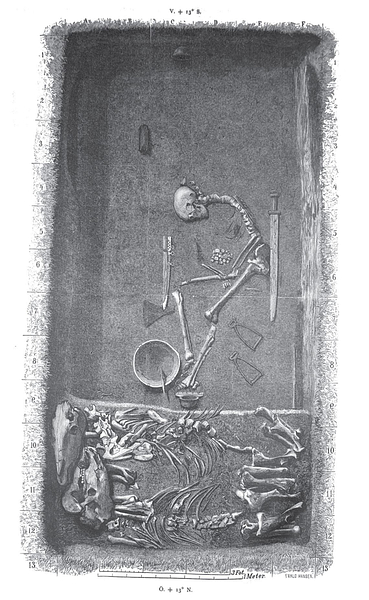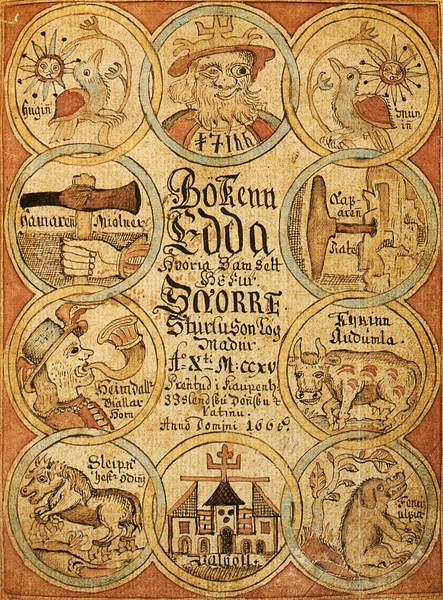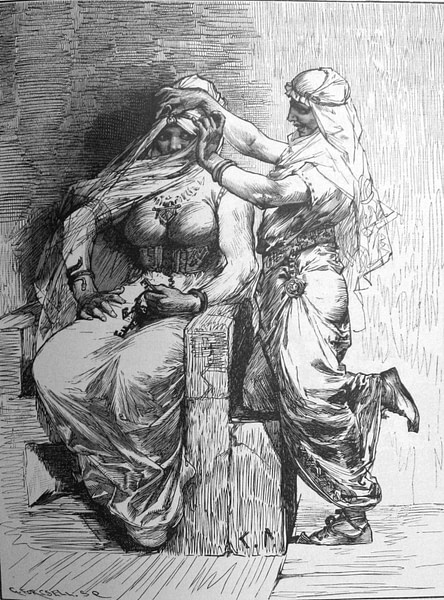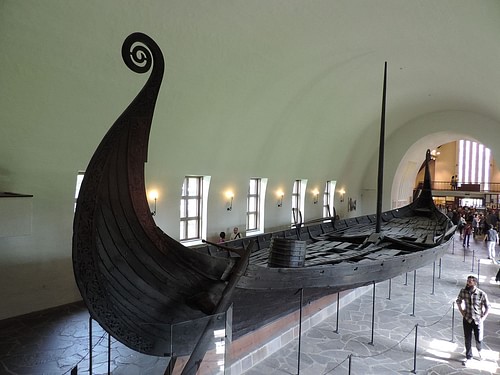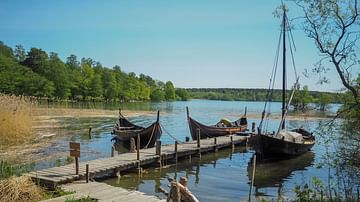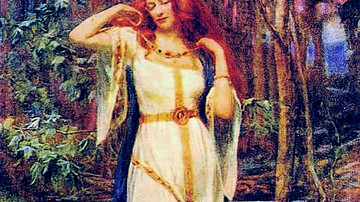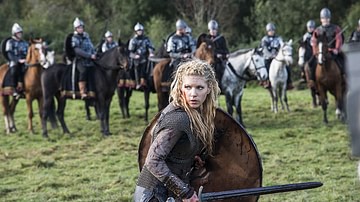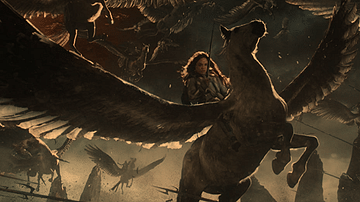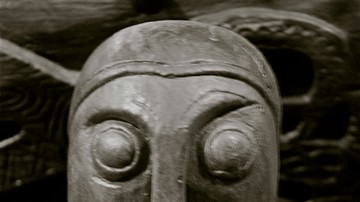In this interview, World History Encyclopedia is joined by American author Nancy Marie Brown, who is talking to us about her new book The Real Valkyrie: The Hidden History of Viking Warrior Women. You can find the entire interview on our YouTube channel.
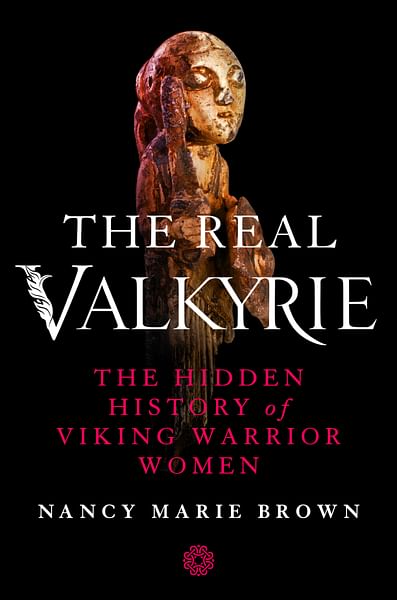
Kelly (WHE): Can you tell us what your book The Real Valkyrie is about?
Nancy Marie Brown (Author): In The Real Valkyrie, I am using two very different kinds of sources. I am using medieval texts and modern archaeology, and I am trying to recreate the life and times of one warrior in the Viking Age. And that warrior just happens to be a woman. When I started writing this book about six years ago, I thought it was going to be a book about bones. I was really interested in what can archaeologists tell us about these bones that they are digging up from the Viking Age with all these new techniques they are using? Well, I kind of learned the hard way that it was going to be a book about bias. So that was a bit of a surprise.
The burial that I decided to focus on has been known for around a hundred years as the ultimate Viking warrior burial. It is called Bj581, and Bj is for Birka, the island in Sweden, it was a Viking town. And this grave was one of 1,100 that was dug up at Birka in the late 1800s. This one was dug up in 1878 and it is the kind of grave called a chamber grave, like a little house underground. In this house, the warrior was seated, maybe on a saddle. There were two horses with bridals, and there was just about every weapon known to the Viking Age. There was a sword, this long knife called a scramasax, arrows, probably a bow, but that has disappeared, an axe, two shields, and two spears. Then on the warrior’s lap, there was a full set of pieces for what is kind of known as Viking chess, the board game hnefatafl. In addition to that, this grave was on a promontory right next to the fortress at Birka, right in line with the Warriors Hall, and it was marked by a large stone.
Because of all these things, the horses, the weapons, the gaming pieces, the location, everybody agreed this was the burial of an important Viking war leader who had something to do with protecting the town of Birka. Then, in 2017, there was this large group of researchers in Sweden, Stockholm, who published the results of a DNA test and several other tests of the bones in this grave, Bj581, and they proved that it was the bones of a woman. So, our ultimate Viking warrior is a woman. The question that I ended up answering in The Real Valkyrie is 'what does the Viking world look like if we abandon these concepts of men's work versus women's work, and we just look at what would it be like if roles were assigned based on different qualities, like ambition, ability, family ties and wealth?' That's the picture of the Viking Age that I try to present in The Real Valkyrie.
Kelly: Amazing! In your book, you have combined the archaeological evidence with a tale of fiction. What made you want to do that?
Nancy: I really wanted to bring these bones to life. I wanted to bring this woman out of the shadows. I wanted to give the reader that vision of what her life could have been like. If you watch a documentary these days, you will see that a lot of times half of it is interviews with experts, and the other half is actors re-enacting some famous battle or voyage or something like that, dressed up in period costume, sometimes speaking lines and sometimes not. And I thought I could do that in a book.
To make it as realistic and believable as possible, I had to start with the skeleton of archaeology and then flesh it out. There was a coin in the grave, so that really helps date it, but based on this coin it could have been anytime from 913 to 980. That is almost the whole 10th century. The placement of the grave makes you think that there was some connection to the Warriors Hall, and we think that burned down c. 965. It was a recent archaeological dig in Birka that dug up the Warriors Hall and established this chronology. 965 is the best guess. If her bones and her teeth tell us that she was 30 or 40 years old when she died, she was probably born around 930.
You can also tell from the chemical studies of the bones and the teeth that she ate well all her life. It was rare in the 10th century for someone to not go through a period of starvation. So, she must have been from a rich family. She could have even been from a royal family. She was also very tall for a woman of her time; around 5'7 (1.7 m). We know she was big and probably strong, a tall female, and well-nourished. We also know she was not a native of Birka, that she came from somewhere else because you can analyse the chemicals on her teeth to find this out.
Her weapons also tell a story. These are not weapons that were there for show. These are not fancy weapons for some honour. These are weapons for killing. Several of them and some items of her clothing are connected to the East Way, which was the trade route through Russia and Ukraine to the Byzantine Empire and the Silk Road. So that is what archaeology can tell me. Then I looked at the history of the Viking Age. Okay, so what else was happening between 930 and 970? What we know about that time we get mostly from stories that were written down hundreds of years afterwards; some of them were written down by Snorri Sturluson in Iceland or by Saxo Grammaticus in Denmark, there are annals in Ireland, there is the Russian Primary Chronicle, and there are many more.
I was particularly looking for stories that happened within her lifetime, and I found lots of references to powerful women, warrior women in the Viking Age. This is what I used when I started writing fictional parts. I decided I would start each chapter with a scene in historical fiction, and then I would step back and carefully explain my sources because it is really important to me that the reader can tell what is fact and what is fiction. One thing I did do just to make it easier to write the stories is I gave her a name. Other skeletons have names; there is Lucy, the Australopithecus, and Ötzi the Ice Man. Well, I call her Hervor.
Kelly: Let us go back to Snorri Sturluson, can you tell us a bit about him?
Nancy: I wrote a biography of him in 2012. It is called The Song of the Vikings, and I really got to know him quite well. We think about this in terms of modern writers all the time, that they cannot be a great writer if they are not a great person. But you cannot apply that to people in the Viking Age or in medieval times. He was a pretty miserable person. If you look at how he treated his wives and his mistresses and his daughters and the terrible relationship he had with his mother, he was a classic misogynist, but he was a great writer. We have to both love him and hate him because if we did not have Snorri, we would not have Norse mythology. I mean, he pretty much was the person who saved Norse mythology. He also included some mythology in his Heimskringla, which is a set of 16 sagas about the kings of Norway. The history in those sagas is not known to us from anywhere else. If he had not written these books, we would be without a lot of our information about the Viking Age.
Kelly: We just have to separate his personal life from his work life. Does he include Valkyries and warrior women in some of his work?
Nancy: He did not say much at all about women, but there were some that he could not drop out of history and he could not drop out of the myths. For instance, the goddess Freyja was not only the goddess of love and fertility but also a goddess of war. And she took half of the dead, and she rode to war in a chariot pulled by a big cat. There was the goddess Skadi, who is the goddess of winter and of skiing, and the only story Snorri tells about her is that she goes to avenge the death of her father. She puts on her armour, gets her weapons, and marches off to the Gods' Hall at Valhalla and she says, you owe me because you killed my father. And they are all afraid to fight her. They offer her all kinds of compensation so that they do not have to fight her.
One of the stories that he does include in the Prose Edda is the story of the Norse creation myth. That is the one that I find interesting because it right up front shows you the difference between the Christian view of women and the Viking view of women. In the Christian creation story, you have God creating Adam in God's own image, and then Adam gets lonely, so God takes Adam's rib, and he creates Eve to be a companion and a servant to Adam. Women are the afterthought, and they are there only to take care of the men. Well, that is not how it works in the Old Norse world.
In the Old Norse myth, you have three gods wandering along the seashore, and they see two driftwood, trees that have washed up: an ash tree and an elm tree. They carve these into human form, and they give them blood and breath and curious minds. They do this at the same time, and the ash tree becomes the man Ask, and the elm tree becomes the woman, Embla. They are made at the same time out of the same stuff by the same gods. If you look at the ash and the elm, what did the Vikings use the ash tree for and what did they use the elm tree for? Well, the ash tree was used for ores and for the shafts of spears, and the elm tree was used for the wheels of carts and for hunting bows. Both men and women had uses in peacetime and uses in wartime, and they were both necessary for society. I like to think that this is a clear vision of what life was like in the Viking Age, that they were different but not fixed into certain roles by their gender.
Kelly: You bring up quite early on in your book that we in the modern age have this idea that Viking women did not fight and they were not warriors. They were buried with keys and they stayed in the house. But then we have these sagas that tell us that this is not true. Where did this concept come from? Why do we think this now?
Nancy: The problem really is that both archaeology and Viking studies started out in the Victorian age in the 1800s, when women, especially elite women, were told to concern themselves with the children, the church, and the kitchen. All the people who are involved in creating the version of the Viking Age that is still in our textbooks had this concept that the rich, the wealthy women, the ones that eat well all their lives would be in the house. They looked around for an image of the perfect Viking housewife, and people have looked very carefully through the sagas, the laws, and the poems. You can find three instances where women have keys on their belts, and the really famous one is not actually a woman, it is the god, Thor, the thunder god, dressed up in drag. This image of Thor dressed up as a bride with the ring of keys at his belt pretty much became the picture of the perfect Viking housewife. The problem with this is there are around three examples in the literature of women with keys, and I found about 20 examples of women with weapons in the histories and the sagas.
Now that we have the DNA test of Bj581, we know that not all the warriors were men. It is not necessarily a gender thing. It is size, and strength, and ability, and ambition that decides whether you are going to be the housewife or the warrior. In the book, I clearly make that distinction because I have Queen Gunnhild, Mother of Kings, who we know from Snorri's Heimskringla, very small and pretty, and she has lots and lots of children. She is pregnant most of the time we know her, while she is a queen making strategies for Viking warfare and pushing her husband and sons into battle. I established her as the one who teaches about weaving and about cloth and about dyeing and that sort of thing.
Kelly: You have incorporated these real women that we know of into the fictional story of Hervor. There were quite a few from different places that Hervor may have travelled. Can you tell us a bit about the women you included in your tale? Were there any women you wanted to incorporate, but they just did not fit in the timeline or the movements of Hervor?
Nancy: Queen Gunnhild, Mother of Kings, I mean, she deserves the whole book to herself. She was this fantastic character who appears in eleven of the Icelandic sagas, and she is mentioned in several histories. She is always the villain. I mean, the men writing about her in the 1200s and later, just really despise the idea that this tiny woman could be ruling Norway. One of them makes it clear that the years that she was ruling beside her sons were called the "age of Gunnhild". It was all about her. She was considered a witch; she was supposed to know all these magical potions and poisons. She kills a lot of people with poison in the book. There is also a suggestion that she might have actually been an archer. Snorri mentions this very interesting scene, the final battle where King Haakon of Norway is killed. Gunnhild and her sons are on the battlefield, the king is hit by an arrow and killed, and there's a question about who shot the arrow. Snorri says something like it is said by many that Gunnhild's servant ran through the crowd saying, make way for the kingslayer and that the servant boy was the one who shot the arrow. But then Snorri says nobody really knows who did it. She is a character that people need to know about.
The second historical person that Hervor meets is this Viking chieftain who is called the Red Girl. She appears in an Irish history, the War of the Irish with the Foreigners, and she is on a list with 15 other named Viking leaders who are harassing the town of Munster in the middle of the 10th century. So, I have Hervor meet her in Dublin and go and fight with her for a while. Then the final person that is featured in the book is Queen Olga of Kiev; her story is told in the Russian Primary Chronicle. It has for a long time been considered legendary and mythical and that she could not possibly have done the things that are in the Chronicle, such as devising the strategy to avenge her husband's death and another leading an army that destroys a city. But then recently, archaeologists have been digging at that city, and they found that it was burned down at about that time when she was in charge. They are finding more and more evidence that she really was real and that she was in charge, and she was a warrior queen in some way.
She learns the story when she is a little girl of Queen Åsa of Vestfold because she lives in the same area where Queen Åsa is buried and Åsa has always been associated with this huge burial mound where the Oseberg ship was discovered. And in the Oseberg ship, there are two women buried. This is really the most elaborate Viking burial that we have ever discovered and been able to excavate. It is the most beautiful ship with all the carvings on it, and there are these two women who were buried there about 100 years before Hervor lived.
There is also the Valkyrie Brynhild. This story has been told over and over and over in many, many, many different versions. It is all about the love triangle between Brynhild, the Valkyrie, and Sigurd, the Dragon Slayer, and the woman he marries, Gudrun, but the oldest versions of it are more about Brynhild being a warrior woman who does not want to get married and being forced to marry. The whole tone of the story changes over time from being her wish to remain in the warband, fighting alongside the kings and bloodying her sword, and her duty to get married and have children and procreate the line. I get to play with that story a bit in the book because, obviously, Hervor wants to remain a warrior and not get married. Those are some of the kinds of stories that I get to tell and the people that you can meet.
Kelly: You fit so much in, and I think it is just brilliant, it is a lot more than just your regular pop culture kind of Vikings. Like you mentioned before, lots of people are going to be more familiar with Vikings, just with Marvel and Thor and Loki, and even the Vikings television show, on the History Channel. How do they go about portraying women on that show? Would you say that they have done quite a good job?
Nancy: They kind of turned me into a fan, like, right away with the very first episode. I was expecting not to like this, you know, because it is hard for me sometimes even to read a novel set in the Viking Age because I know too much, and I keep finding little things that are wrong, and it kicks me out of the story. The very first episode of the Vikings TV show starts with this totally cliched Viking raid, you know, the big hairy men with the swords, and they beach their boats, and they run through the beautiful little village, and they are killing people, setting houses on fire, and the camera singles out this blonde woman and her beautiful little children. This is Lagertha, played by Catherine Winnick, and she whips the poker out of the fire, and she beats the crap out of these two men, and it is this awesome fight scene. She is obviously a well-trained martial artist, and they are not.
She is obviously a well-trained martial artist, and they are not. When I started researching this book and I was reading Saxo Grammaticus, I come across Lagertha, and she is very much like she is portrayed by Catherine Winnick in the History Channel Vikings. I mean, Saxo calls her a skilled female fighter who would do battle in the forefront of the most valiant warriors. Saxo is just as misogynistic as Snorri, but he cannot tell some of the stories about the Viking Age without including these worrior women.
Kelly: Why do you think we are still so fascinated by the Vikings today?
Nancy: Well, you know, we talked a lot about Snorri Sturluson being a misogynist and an awful person, but I think it is really because of him and the stories that he wrote down and the stories that other people inspired by him or even taught by him wrote down. I have said before, and I will say it again, he is the greatest writer of the Middle Ages. He was responsible for writing down almost everything we know about Norse mythology, for preserving hundreds of lines of Viking poetry.
I would say the second factor in why we still love the Vikings is those beautiful ships, the Viking ships that were dug out of the blue clay of Southern Norway and recovered from Danish harbours. They are beautiful ships, but they would not have had as much meaning for us if we did not have the stories to go along with them. If we did not know from the sagas where the Vikings travelled in their ships and how dangerous and exciting it was. For that, you have to have the sagas, so I come back to the sagas as being the reason that we still love the Vikings. Snorri really was a storyteller; he writes these things with pacing and humour and suspense and great characters that just really make you want to keep reading.
Kelly: Thank you so much for joining me today. It has been brilliant.
Nancy: Thanks a lot, Kelly.

